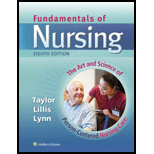
Concept explainers
To identify:
The beneficial aspect of the stress experienced by this student nurse.
Case summary:
The nursing student Ms. S goes to the student health center and says she feels sick. The nursing student was very much in stress and fear of her clinical instructor and also with the tubes and machines in the critical care unit. Ms. S has a critical care rotation and she is very much afraid to tell her clinical instructor, tries to switch the clinical rotation but she failed. Due to immense stress, the nursing student feels migraine is coming over her.
To discuss:
The student nurse handling of this stressful situation facilitate her ability to deliver effective care and treatment to her patients in a new environment.
Case summary:
The nursing student Ms. S goes to the student health center and says she feels sick. The nursing student was very much in stress and fear of her clinical instructor and also with the tubes and machines in the critical care unit. Ms. S has a critical care rotation and she is very much afraid to tell her clinical instructor, tries to switch the clinical rotation but she failed. Due to immense stress, the nursing student feels migraine is coming over her.
To discuss:
Whether the nursing student’s interaction with her instructor reinforce her commitment to treating patients with dignity and respect?
Case summary:
The nursing student Ms. S goes to the student health center and says she feels sick. The nursing student was very much in stress and fear of her clinical instructor and also with the tubes and machines in the critical care unit. Ms. S has a critical care rotation and she is very much afraid to tell her clinical instructor, tries to switch the clinical rotation but she failed. Due to immense stress, the nursing student feels migraine is coming over her.
Want to see the full answer?
Check out a sample textbook solution
- 69. 70. 71. 72. 73. 74.arrow_forward63. 64. 65. Rhythm: P wave: QRS Complex: Rate: PRI: Interpretation: Rhythm: P wave: QRS Complex: 66. 67. 68. Rhythm: P wave: QRS Complex: Rhythm: P wave: QRS Complex: Rate: PRI: Interpretation: Rate: PRI: Interpretation: Rate: PRI: Interpretation:arrow_forward59. 57. 60. 62. 55. سلسلہ ་་་་arrow_forward
- • Define the first stage of labour. • Describe the physiology of the first stage of labour. • Enumerate any four (4) potential complications during puerperium and highlight key measures to manage these complications.arrow_forward• Define obstetric emergencies and state and briefly explain any two (2) maternal, foetal, and obstetric complications that require immediate intervention. • Explain how mental health services can be effectively integrated into maternal and child health, viz-a-viz early childhood development. • Enumerate any four (4) foetal malpresentations in pregnancy and briefly explain their implication in labour while also highlighting their causes and possible complications.arrow_forward• Briefly highlight the physiological changes in pregnancy in relation to cardiovascular and endocrine systems, as well as the uterus and the skin. • Discuss the current antenatal care approach for pregnant women and provide the highlight of activities conducted during woman’s antenatal visit, clearly describing the steps needed for successful antenatal care. • Enumerate any three (3) abnormalities related to placental development and their implications to pregnancy or childbirth.arrow_forward
- 58 64. Rhythm: Clues: Rhythm: Clues: 62 Rhythm QRS Complex Rates PRI Interpretation Rhythm: P wave QRS Complex Rate PRI Interpretation Rhythm: Clues: Rhythm P wave: QRS Complex Rate PRI Interpretation: Rhythm: P wave: QRS Complex: Rate: Interpretation: 67 Rhythm: P wave: QRS Complex: Rate: PRI Interpretation: Rhythm: P wave: QRS Complex: Rate: PRI Interpretation: 68 Rhythm P waves QRS Complex Rate PRI Interpretation Rhythm P wave QRS Complex Rhythm: P wave QRS Complex: Rate PRI Interpretations Rate PRI Interpretationarrow_forward51. 52. 53. Rhythm: Clues: Rhythm: Clues: Rhythm: Clues:arrow_forwardRegularity- Rate- P waves- PRI- QRS- Interpretation- atrial dysrthmia,junctional dysrthymia,and ventricular rhythm,heart blocks,normal sinus,PVCarrow_forward
- normal sinus,atrial dysrthmia,junctional dysrthymia,and ventricular rhythm,heart blocks,PVCarrow_forwardnormal sinus,atrial dysrthmia,junctional dysrthymia,and ventricular rhythm,heart blocksarrow_forwardA 40-year-old male farmer was rushed to an ER with complaints of fever, abdominal pain/tenderness, nausea and vomiting. Clinical examination and investigations revealed diagnosis of typhoid perforation and he was booked for exploratory laparotomy. Explain in detail the pre - operative care of this patient.arrow_forward
 Phlebotomy EssentialsNursingISBN:9781451194524Author:Ruth McCall, Cathee M. Tankersley MT(ASCP)Publisher:JONES+BARTLETT PUBLISHERS, INC.
Phlebotomy EssentialsNursingISBN:9781451194524Author:Ruth McCall, Cathee M. Tankersley MT(ASCP)Publisher:JONES+BARTLETT PUBLISHERS, INC. Gould's Pathophysiology for the Health Profession...NursingISBN:9780323414425Author:Robert J Hubert BSPublisher:Saunders
Gould's Pathophysiology for the Health Profession...NursingISBN:9780323414425Author:Robert J Hubert BSPublisher:Saunders Fundamentals Of NursingNursingISBN:9781496362179Author:Taylor, Carol (carol R.), LYNN, Pamela (pamela Barbara), Bartlett, Jennifer L.Publisher:Wolters Kluwer,
Fundamentals Of NursingNursingISBN:9781496362179Author:Taylor, Carol (carol R.), LYNN, Pamela (pamela Barbara), Bartlett, Jennifer L.Publisher:Wolters Kluwer, Fundamentals of Nursing, 9eNursingISBN:9780323327404Author:Patricia A. Potter RN MSN PhD FAAN, Anne Griffin Perry RN EdD FAAN, Patricia Stockert RN BSN MS PhD, Amy Hall RN BSN MS PhD CNEPublisher:Elsevier Science
Fundamentals of Nursing, 9eNursingISBN:9780323327404Author:Patricia A. Potter RN MSN PhD FAAN, Anne Griffin Perry RN EdD FAAN, Patricia Stockert RN BSN MS PhD, Amy Hall RN BSN MS PhD CNEPublisher:Elsevier Science Study Guide for Gould's Pathophysiology for the H...NursingISBN:9780323414142Author:Hubert BS, Robert J; VanMeter PhD, Karin C.Publisher:Saunders
Study Guide for Gould's Pathophysiology for the H...NursingISBN:9780323414142Author:Hubert BS, Robert J; VanMeter PhD, Karin C.Publisher:Saunders Issues and Ethics in the Helping Professions (Min...NursingISBN:9781337406291Author:Gerald Corey, Marianne Schneider Corey, Cindy CoreyPublisher:Cengage Learning
Issues and Ethics in the Helping Professions (Min...NursingISBN:9781337406291Author:Gerald Corey, Marianne Schneider Corey, Cindy CoreyPublisher:Cengage Learning





